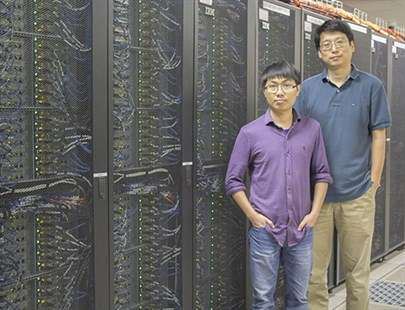Two-dimensional multiferroics in monolayer group IV monochalcogenides

Electronic devices have been constantly decreasing in size and increasing in speed and efficiency, from miniaturized personal computers to pocket-sized cell phones. Researchers in the Department of Materials Science and Engineering at Texas A&M University have discovered a class of two-dimensional (2-D) materials to aid in further reducing the size and improving the performance of various devices.
Dr. Xiaofeng Qian, an assistant professor, and Hua Wang, a graduate student in the department, were featured in a recent issue of 2-D Materials for their work in 2-D multiferroic materials.
"Most 2-D materials studied so far have shown one ferroic characteristic," Qian said. "When we looked into group IV monochalcogenide layers, we discovered that these 2-D materials have two ferroic characteristics simultaneously."
Their paper "Two-Dimensional Multiferroics in Monolayer Group IV Monochalcogenides" demonstrates a special class of two-dimensional semiconductors. These materials are special due to their ability to exhibit a large spontaneous lattice strain called ferroelasticity, and a giant switchable electric polarization called ferroelectricity. These properties appearing simultaneously in the monolayer group IV monochalcogenides lead to 2-D ferroelastic-ferroelectric multiferroicity.
"2-D materials with more than one ferroic characteristic can be very useful for miniaturized multifunctional devices such as sensors and actuators," Qian said. "However, they are very scarce in nature."
This unique class of 2-D multiferroic materials could be useful for 2-D ferroelectric memory and ferroelastic memory that are as thin as one nanometer. In pocket-sized devices, this new material could help make the device smaller by decreasing the size of the sensors and materials inside the device. They can also be useful for exploring ferroelectric excitonic photovoltaics that take advantage of both large ferroelectricity and extraordinary excitonic optical absorption.
"Additionally, these 2-D materials with multiple ferroic orders provide an ideal platform to demonstrate 2-D nonvolatile photonic memory with much lower power consumption and at a faster speed," Qian said.
Currently, the group is working to better understand the microscopic mechanisms of the domain wall motion and discover other novel 2-D multiferroic materials.
"Our ultimate goal in this project is to design multiferroicity into 2-D materials," Qian said. "We also want to be able to fine tune and control their multiferroicity for a variety of electronic, optical and energy applications."
Results of the duo's work will provide new opportunities for 2-D multifunctional materials research toward miniaturized energy efficient applications.
"Many interesting properties and potential applications have been discovered in 2-D materials and their hybrid structures. There are a lot of new fascinating properties waiting to be discovered," Qian said. "It is so fortunate and exciting to work in this field and understand their fundamentals and implications for future device and energy technologies."
More information: Hua Wang et al. Two-dimensional multiferroics in monolayer group IV monochalcogenides, 2D Materials (2017). DOI: 10.1088/2053-1583/4/1/015042
Provided by Texas A&M University





















